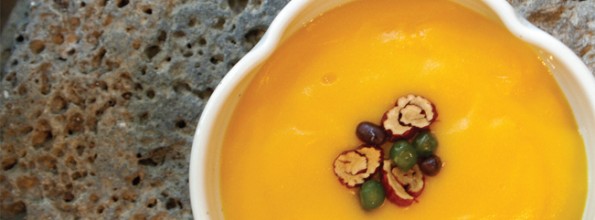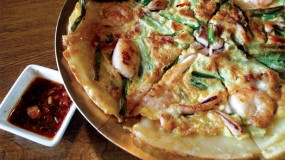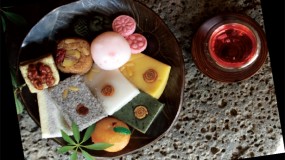Home » Archives by category » Intro to Korea (Page 10)

Juk is a porridge made with cereals. There are various types of Juk, depending on its ingredients, such as cereals, vegetables, meat, and seafood. Hobakjuk, made with pumpkin, is one of the most famous kinds of Juks, due to its sweet taste and beautiful color.
Foods

Haemul-pajeon is a dish made by pan-frying green onion and seafood in mushy dough. It goes well with Makgeolli, Korean traditional rice wine. Dongnae-pajeon from the Busan city is the most famous Haemul-pajeon; it was even presented to the king during Joseon Dynasty(1392~1910).
Foods

Mul-naengmyeon, made with buckwheat noodles in chilled broth, is one of the most popular dishes during hot summer. People living in the northern region mainly enjoyed this, since buckwheat is mostly produced there. Mul-naengmyeon has been particularly famous in Pyeongyang (capital of North Korea) during winter.
Foods

Tteok is generally made by kneading rice powder with water and then steaming or shaping it. It has various types in accordance with different recipes and ingredients. It is the must-have food in many of Korean traditional events and feasts, like holidays, marriages, funeral ceremonies and ancestral rites.
Regions
Hamgyeong-do is the peninsula’s most mineral-rich province. It borders China and Russia. Cheongjin, in North Hamgyeong Province, is an advanced industrial complex with a harbor through which trade with Japan and Russia flows. Hamgyeong-do also boasts many ancient tombs and fortress walls along with well-preserved historic relics such as the old Cheonghaetoseong Fortress from the [...]
Regions
Behind Yanggang-do is the mountainous province Jagang-do. Landlocked and rich in zinc, gold, copper, tungsten and other mineral deposits, it is deservedly called Korea’s buried treasure. It also possesses abundant forestry and water resources. Goguryeo archeological digs are scattered around many of the province’s rural areas like Unpyeong-ri, Simgwi-ri and Songam-ri.
Regions
Yanggang-do is North Korea’s most abundant province in terms of forestry. Baekdu-san, the highest mountain on the Korean Peninsula, is its crown jewel, and atop the mountian is the beautiful crater lake Cheonji. The mountain teems with rare plant and animal life. The province’s Pungsan region (Gimhyeonggwon County) is the origin of the Pungsan Dog, [...]
Regions
Gangwon-do is a divided province in a divided nation. The North Korean half is as mountainous as the South Korean. It hugs the rich fishing areas of the East Sea. Shipbuilding is its major industry. World-famous Geumgang-san (1,638m), or Diamond Mountain, opened to South Koreans in November 1998, the first North Korean tourist site made [...]
Regions
Hwanghae-do has been an economically and culturally developed region from early days. Handicrafts such as Goryeo porcelain enabled Gaeseong, capital of the Goryeo Dynasty (918-1392) to develop thriving external trade and serve as a commercial center in both the Goryeo and Joseon eras. Currently, South-North economic cooperation has been actively progressing here through the joint [...]
Regions
Pyongyang is a city steeped in history. It retains cultural relics from ancient Gojoseon (2333-108 B.C.), the first nation established on the Korean Peninsula, and more relics from the Goguryeo Kingdom (37 B.C.- A.D. 668) than any other Korean city. Goguryeo was once the most powerful nation in Northeast Asia. Pyongyangseong Fortress (National Treasure No. [...]







 Copyright @ 1999-2012 VANK. All rights reserved.
Copyright @ 1999-2012 VANK. All rights reserved.